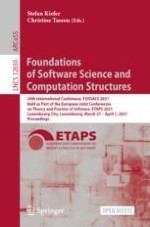Open Access 2021 | Open Access | Book

Foundations of Software Science and Computation Structures
24th International Conference, FOSSACS 2021, Held as Part of the European Joint Conferences on Theory and Practice of Software, ETAPS 2021, Luxembourg City, Luxembourg, March 27 – April 1, 2021, Proceedings
Editors: Assoc. Prof. Stefan Kiefer, Christine Tasson
Publisher: Springer International Publishing
Book Series : Lecture Notes in Computer Science

 for leaderless protocols. Further, for the special class of symmetric protocols they reduce these bounds to
for leaderless protocols. Further, for the special class of symmetric protocols they reduce these bounds to
 and
and
 , respectively. The problem of lowering these upper bounds or finding matching lower bounds is left open. We show that the cut-off problem is
, respectively. The problem of lowering these upper bounds or finding matching lower bounds is left open. We show that the cut-off problem is
 -complete for leaderless protocols,
-complete for leaderless protocols,
 -complete for symmetric protocols with a leader, and in
-complete for symmetric protocols with a leader, and in
 for leaderless symmetric protocols, thereby solving all the problems left open in [17].
for leaderless symmetric protocols, thereby solving all the problems left open in [17].